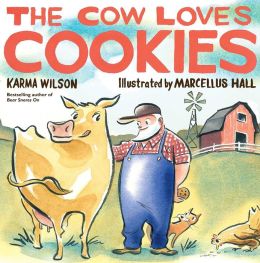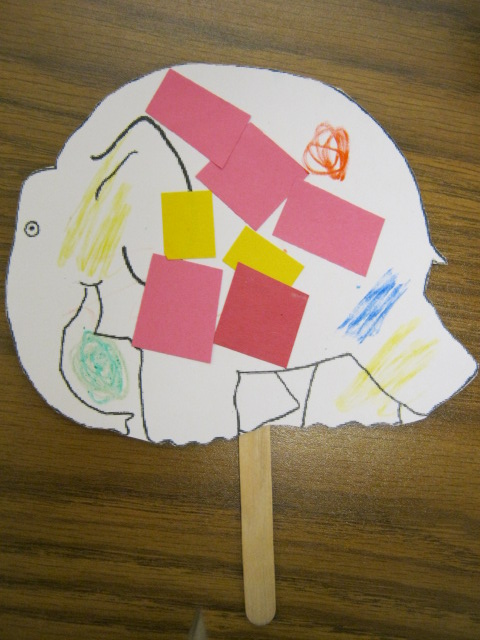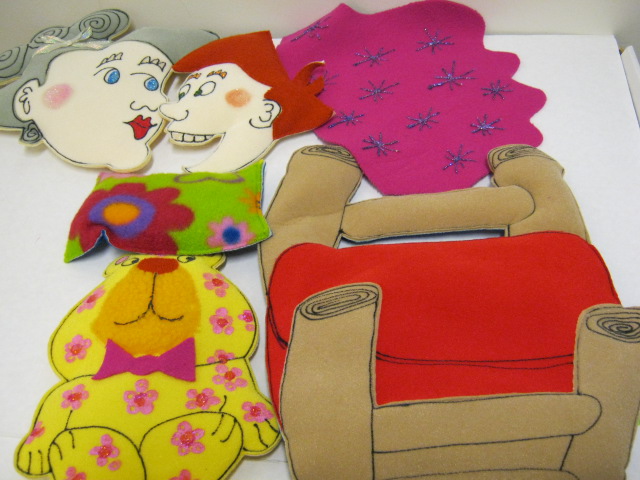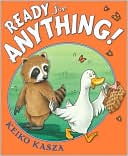Introduce the book The Doorbell Rang by Pat Hutchins. Have children repeat the phrase "No one makes cookies like Grandma."
Read the book. Count the cookies on one plate as more children arrive. Early Literacy Aside--Empower: The kitchen is a great place for activities around counting and measuring whether you use recipes or not. A “handful” is a measurement! How does the amount in your handful compare to the amount in your child’s handful? The bathtub is another great place to play with measurement, pouring water from one container to another. I have a handout here to go with The Doorbell Rang. You and your children can cut out the twelve cookies and plates and see how the cookies are divided as more children come. Handout: doorbellranghandout
Cow Loves Cookies by Karma Wilson Handout

Read the book The Cow Loves Cookies by Karma Wilson. Have participants join in with the repeated phrase "but the cow loves cookies."
Early Literacy Aside--Empower: At the end of storytime pass out the attached handout. Tell the adults they can cut out the pictures with their children and play different games. Children can match the animals to what they eat. Use the pictures to help children retell the story, too! Young children can say the sounds of the animals. Have children say the repeated phrase “but the cow loves cookies.” Older children can retell the story using the pictures to remember the order. All these are steps to help your children retell stories and help them understand how stories work which will later make it easier for them to understand what they are reading. Handout: cowlovescookies
Joseph Had an Overcoat by Simms Taback
Read book: Joseph Had an Overcoat by Simms TabackHave children say the repeated phrase, "But it got old and worn."
Retell with flannel board: Now let's do the story on the flannel board. What happened first?
Early Literacy Aside--Empower: [As you give out the handout] I have a handout for you today for Joseph Had an Overcoat. It is the same pattern that I used for the flannel board. You can cut out the pieces and have your children retell the story. As you have your children retell other stories too, using props can help them remember what comes next. For your younger children who may not be able to retell stories, they can repeat a word or perhaps a phrase. These are all activities that will later help your child understand how stories work and also help them understand what they read. Pattern for flannel board and handout: josephovercoathandout
Elmer by David McKee Craft
Extension Activity: Elmer PuppetHand out elephant cut outs on white card stock and colorful construction paper squares to glue to the elephant or crayons to color the elephant. They then glue a popsicle stick to the back. Encourage children to describe what they made and to retell the story using their puppet. Adults with babies can make a colorful elephant to move in front of their babies’ eyes and talk about the shapes and colors.
Early Literacy Aside--Empower: Adults as you play with your children or make crafts with them, try to use a word they are less familiar with. Children learn words best through their experiences, not by memorizing words. You might use less familiar words for colors, like fuschia or magenta, or perhaps the way the elephant is walking, lumbering slowly along. You have many opportunities throughout the day to build your children’s vocabulary. It is these little things you do over and over again that make a difference. 
Submitted by Katie Ringenbach, Bucks County (PA) Public Library
There Were Ten in the Bed by Annie Kubler
Extension Craft Activity: Five in the Bed Handout
Half-sheet of construction paper cut lengthwise and figures for children to decorate. Younger children glue five figures in the bed; older children decorate with more detail. Each child also gets a brad so that they can rotate their figures onto and out of the bed as in the book/song.
Early Literacy Aside--Empower: Adults, your children are not only using their art to reinforce retelling the story There Were Ten in the Bed we read today, but also to reinforce our early literacy skill. Singing is a great way to support phonological awareness in that it slows down the words and gives a different note to each syllable, so today’s activity is a 2 for 1!
Submitted by Katie Ringenbach, Bucks County (PA) Public Library
What! Cried Granny by Kate Lum
Early Literacy Aside--Explain: Our early literacy tip today is on print motivation, your children's enjoyment of books and reading. Children who have had positive experiences around books and reading before going to school are more likely to stick with learning to read even if it is difficult. I'll be pointing out some ways to make booksharing enjoyable in today's storytime. Book and flannel board: What! Cried Granny: An Almost Bedtime Story by Kate Lum is our next book. It's about a boy who is having a sleep-over at his grandmother's house. Let's see what happens when he tries to get the things he needs to go to sleep. Granny is often surprised and says in a loud voice,

"What!" Let me hear you all say that. You can join in as we go through the story.
Early Literacy Aside--Example: There are many ways to have children participate in stories as we read together. Having them participate as we read the story helps them enjoy the story more.
Submitted by Katie Ringenbach, Bucks County (PA) Public Library
Little Red Hen Handout
Early Literacy Aside--Empower: In our storytime today, we read the story of the Little Red Hen by Byron Barton. Your children also retold the story with me on the flannel board. In today's handout I have the repeated phrases and the order of what the little red hen did. There are also boxes for your children to draw the animals. You can cut them out and have the children retell the story for you. For your younger children, they can say the words "Not I" or say the sounds of the animals. Having your children retell stories helps them understand the story better and helps them learn how stories work. Enjoy!Handout: lrhenhandout
Night/Noche Storytime Handout
Early Literacy Aside--Empower: I have a handout for you on the topic of our storytime today--night. It has some book titles which I have also displayed here. I hope you'll like the suggestions of ideas and techniques you can do with your children at home to help develop their pre-reading skills, just as you saw me do in the storytime. You are with your children more often than I am so you have many opportunities to use some of these ideas. Let me know which ideas you enjoy doing with your children.Storytime Handout for storytime on the theme of Night/Noche Handout in English Nighthandoutkc Handout in Spanish Nochehandoutkc
Submitted by Katie Cunningham
Ideas que le ayudarán a fomentar la alfabetización temprana en casa: Al final de este parrafo encontrará un folleto con el tema de la noche. El folleto habla de algunos libros que también se presentan aquí. Espero que estas ideas y técnicas le ayuden en casa a sus ninos a desarrollar las habilidaes necesarias para que puedan aprender a leer, así como lo ha visto en nuestra hora de cuentos. Usted pasa mas tiempo consus hijos del que ellos pasan conmigo, así es que tendrá muchas oportunidades de usar algunas de estas ideas.
Five Scrumptious Cookies
We sing this song after reading Wolf's Chicken Stew by Keiko Kasza. The first time you come to the word scrumptious, add the words delicious or yummy. [If you prefer you can tlak about the word scrumptious before starting the book.]Early Literacy Aside--Example: When a book has a word that is unfamiliar to your child, this is a great opportunity to build vocabulary. Don't replace the word with a simpler one, just explain it briefly. Books have rich language, more unusual words than we use in daily conversation. Five Scrumptious Cookies Five scrumptious cookies in the baker’s shop Big and round with some sugar on top Along came a boy with a penny to pay Who bought a scrumptious cookie and took it away.
Four scrumptious cookies . . . Three scrumptious cookies . . . Two scrumptious cookies . . . One scrumptious cookie . . . No scrumptious cookies . . . Big and round with some sugar on top No one came with a penny to pay. So close the baker’s shop and have a baking day.
Llama, Llama Time to Share by Anna Dewdney
Read Llama, Llama Time to Share by Anna Dewdney.Point out some word pairs that rhyme, such as boat and moat. Ask children what other words rhyme with boat (they don't have to make sense). Early Literacy Aside--Example: Helping children hear words that rhyme is one way to help them hear the smaller sounds in words which will then later help them sound out words. storytimehandoutlorenasearsPA Early Literacy Aside--Empower: I have a handout for you with suggestions for some rhyming games and ways to help your children hear the smaller sounds in words. Lorena Sears, F D Campbell Memorial Library (PA)
Breakfast for Jack by Pat Schories
Our next book is a wordless book. It has pictures but no written words. Let's see if you can figure out what the story could be just from the pictures. Read through Breakfast for Jack by Pat Schories (or another wordless book of your choice) Let the children contribute to the conversation as you go through the pictures in the book.
Early Literacy Aside--Example: Using wordless books and having your child tell the story is one easy way to develop your children's narrative skills--having them tell stories. They can tell the story different ways when reading the book several times.
Early Literacy Aside--Empower: I have displayed some wordless books today. Feel free to check them out and have your children tell you the story. If they seem to be stuck, you can ask open-ended questions like "What do you see in this picture? What do you think is happening here?" If you are telling the story together, remember to follow your child's lead. Supporting your children's narrative skills helps them later understand what they read.
Read through Breakfast for Jack by Pat Schories (or another wordless book of your choice) Let the children contribute to the conversation as you go through the pictures in the book.
Early Literacy Aside--Example: Using wordless books and having your child tell the story is one easy way to develop your children's narrative skills--having them tell stories. They can tell the story different ways when reading the book several times.
Early Literacy Aside--Empower: I have displayed some wordless books today. Feel free to check them out and have your children tell you the story. If they seem to be stuck, you can ask open-ended questions like "What do you see in this picture? What do you think is happening here?" If you are telling the story together, remember to follow your child's lead. Supporting your children's narrative skills helps them later understand what they read.
Little Red Hen Readers' Theater
Introduce the book Little Red Hen by Byron Barton: This is a folktale that many authors have retold. The book we are going to read was written and illustrated by Byron Barton. [Have several copies of the book available, or copied sheets.] Today with your help, we are going to read by doing what is called Readers' Theater. This is playacting without having to memorize any lines. I will act as narrator, but I will need the rest of you to participate as well. Let's divide into three groups: pig, duck, and cat. Now I will need four parent volunteers and your children to come to the front to read the lines of the characters. After you have read the lines, encourage the children to repeat after you. After the child says your words then the children in groups will say those words as well.Clap for all the participants--children in groups, children up front, parents. Talk briefly about the story by asking questions such as How would you feel if you were the little red hen? What would you have done? What do you think the pig, duck and cat might do next time? Early Literacy Aside--Example: When you have children act out stories, it is not only fun, but this kind of dramatic play helps them understand how stories work and helps them understand the story. These are skills that will help them understand what they read when they get to school. Lillie Butler, St. Tammany Parish (LA) Library
Animals Storytime Handout
Animals Storytime Handout animalhandvocabcarolwagstaffdouglascolplby Carol Wagstaff, Douglas County (CO) Public Library
Zoo Storytime Handout
Zippety Zoo Storytime Handout yadkinnchandoutzippetyzoo by Lynne Reed, Yadkin County (NC) Public Library
Junglemania Storytime Handout
Junglemania Storytime Handout: yadkinnchandoutJunglemania by Lynne Reed, Yadkin County (NC) Public Library
Eensy Weensy Spider by Mary Ann Hoberman
During the storytime, introduce book: Our next book is called The Eensy Weensy Spider. It has the eensy weensy spider rhyme that we are familiar with. Let's say it together (show first page). Now the author, Mary Ann Hoberman, has made up some new verses. I'll read you one of my favorite ones: The eensy weensy spider fell down and scraped her knees.
"Ouch!" cried the spider. "I need some Band-Aids, please!"
"How many?" asked her mama. "I only have a few."
Said the eensy-weensy spider, "Six of them will do."
The eensy weensy spider fell down and scraped her knees.
"Ouch!" cried the spider. "I need some Band-Aids, please!"
"How many?" asked her mama. "I only have a few."
Said the eensy-weensy spider, "Six of them will do."
Optional--talk about how many legs/knees a spider has . . . Early Literacy Aside--Explain: All of these rhymes based on the original, piggyback rhymes, have new rhyming word combinations. Pointing out the rhyming words or letting your children fill in a rhyming word helps them hear the smaller sounds in words which will help them later to sound out words when they learn to read. Early Literacy Aside--Empower: You noticed that today we read a bok with piggyback rhymes. You and your children can pick a rhyme they know well and then make up your own words to new rhymes. Having your children think of rhyming words is one way to support phonological awareness, hearing the smaller sounds in words. This is a fun activity and also helps your children later to sound out words. Enjoy!
Something from Nothing by Phoebe Gilman
Early Literacy Aside--Empower: Earlier in our storytime we read the book Something from Nothing and then you helped tell the story with the flannelboard. Today I have a handout for you, so that you can color and cut out the pieces from the rectangular blanket and then retell the story at home. Adults, when you give your children little aids or props, it helps them remember the story and retell it. When children retell stories they are better understanding how stories work as well as the story itself. This will help them later understand what they read. Have fun together!Handout: handsomnothpattskill
Library Staff: You can enlarge the handout to make your own flannelboard.
Submitted by Saroj Ghoting, Early Childhood Literacy Consultant www.earlylit.net
Ready for Anything by Keiko Kasza

Submitted by Sophie Bruno, Sacramento (CA) Public Library
Big Chickens by Leslie Helakoski
 Book Introduction: Our next book is one of my favorite books called Big Chickens by Leslie Helakoski. There are three chickens and each of the chickens here is holding one of the letters for the word "big". Here is a B and an Iand a G.
Read the book.
Early Literacy Aside--Example: From time to time it is fun to point out letters as I did with the word BIG. You don't need an alphabet book to talk about letters.
Early Literacy Aside--Empower: Did you know that when your child plays with shapes or blocks and you talk about the shapes you are preparing them to learn to recognize letters!
Book Introduction: Our next book is one of my favorite books called Big Chickens by Leslie Helakoski. There are three chickens and each of the chickens here is holding one of the letters for the word "big". Here is a B and an Iand a G.
Read the book.
Early Literacy Aside--Example: From time to time it is fun to point out letters as I did with the word BIG. You don't need an alphabet book to talk about letters.
Early Literacy Aside--Empower: Did you know that when your child plays with shapes or blocks and you talk about the shapes you are preparing them to learn to recognize letters!
Submitted by Diane Christensen, Sacramento (CA) Public Library
Don't Let the Pigeon Drive the Bus by Mo Willems
 Read the book Don't Let the Pigeon Drive the Bus by Mo Willems. Then flip back to a page with big angry font and read it in an angry tone of voice while pointing to the words.Early Literacy Aside--Example: Parents, here you can see how the text is reflecting the meaning of the words. From time to time, pointing to the words and having your voice reflect what is being said, or how it is said, helps children understand the meaning of what is going on. In this way you are supporting both print awareness and comprehension.
Read the book Don't Let the Pigeon Drive the Bus by Mo Willems. Then flip back to a page with big angry font and read it in an angry tone of voice while pointing to the words.Early Literacy Aside--Example: Parents, here you can see how the text is reflecting the meaning of the words. From time to time, pointing to the words and having your voice reflect what is being said, or how it is said, helps children understand the meaning of what is going on. In this way you are supporting both print awareness and comprehension.
Laura, Sacramento (CA) Public Library


